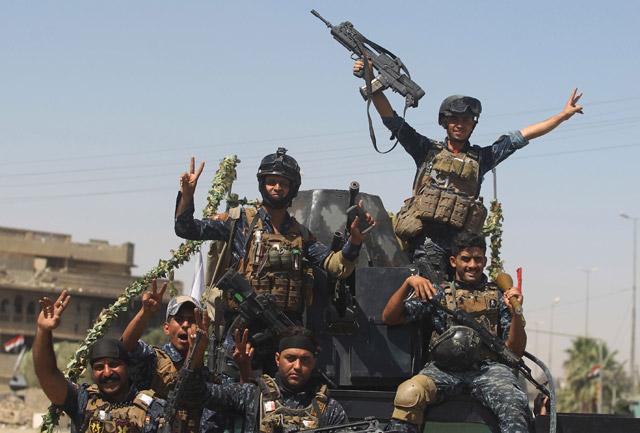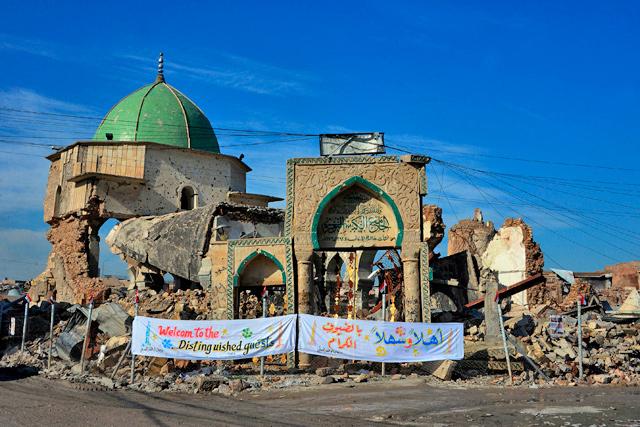You are here
Gunfire cuts short celebrations at recaptured Mosul mosque
By AFP - Jul 01,2017 - Last updated at Jul 01,2017
MOSUL, Iraq — Iraqi soldiers snap victorious “selfies” and pose with a captured Daesh terror group flag at the Mosul mosque where extremist chief Abu Bakr Al Baghdadi once spoke.
“Where is Baghdadi?” they say, taunting the absent extremist leader at the site of his triumphal 2014 appearance, the only time he is known to have appeared in public as the head of Daesh’s now-crumbling cross-border “caliphate”.
They hold the extremists’ flag upside-down because “this is the flag of the defeated” Daesh, and declare that the special forces will remain — a play on one of the group’s slogans.
The euphoria, however, is short-lived, with incoming fire putting an end to the celebrations.
There is a burst from a Kalashnikov assault rifle, followed by a shot from a sniper that strikes the entrance of the mosque, then another shot, and another burst.
The members of Iraq’s elite Counter-Terrorism Service (CTS) return to the safety of their armoured vehicles and soon leave the area, where one of their own was killed and three more wounded by a Daesh sniper the evening before.
After seizing Mosul in June 2014, a black-robed Baghdadi appeared at Friday prayers at the Grand Mosque of Al Nuri and called on Muslims to obey him, making the site a potent symbol of the extremists’ rule.
As Iraqi forces closed in, Daesh blew up the mosque and its famed leaning minaret, which was affectionately known as Al Hadba (the hunchback), leaving the site in ruins when it was recaptured on Thursday.
“We came close to the mosque and minaret but the enemy brought them down,” says Ali Dhiaa, a sergeant in the CTS who sadly contemplates the damage.
“These were icons for us. By taking them down, the enemy blew up the civilisation,” Dhiaa says.
Shots echo through the area, and then a dull explosion is followed by a huge cloud of smoke, marking the site of an air strike carried out by Iraq or the coalition of countries supporting its forces in the battle.
Mountains of debris
Several other strikes follow in the next half hour.
Reaching the area required Dhiaa to manoeuvre his black armoured vehicle through mountains of debris in what remains of Mosul’s Old City: an ocean of rubble and crushed vehicles where the final scenes of the battle for Iraq’s second city are unfolding.
Only the base of Al Hadba minaret now remains, and while its dome is still standing, there is a gaping hole in the structure under it, and two-thirds of Nuri mosque has been destroyed.
The half naked, burned corpse of a extremist lies in front of a ruined store near the remains of the mosque.
The minaret, which was completed in 1172 and had been listing for centuries, is featured on Iraq’s 10,000-dinar banknote and was the main symbol of Mosul, giving its name to countless restaurants, companies and even sports clubs in the city.
Its loss left the country in shock, but the destruction had been widely anticipated, with commanders saying Daesh would not have allowed Iraqi forces to score a hugely symbolic victory by recapturing the site.
Daesh claimed on its Amaq propaganda agency that the site was hit in a US air strike, but the US-led coalition said it was the extremists who had “destroyed one of Mosul and Iraq’s great treasures”.
Even after Daesh destroyed it, recapturing the Nuri Mosque has provided a boost to Iraq’s forces and government, with Prime Minister Haider Al Abadi declaring that the extremists’ “caliphate” is coming to an end.
Iraqi forces made a rapid advance to retake the symbolic site, but must still brave sniper fire for celebratory visits for now.
Related Articles
MOSUL, Iraq — Iraq declared the Daesh terror group’s “caliphate” was coming to an end after it recaptured Mosul’s iconic Nuri Mosque Thursda
MOSUL, Iraq — Iraqis on Sunday laid the cornerstone in rebuilding Mosul's Al Nuri Mosque and leaning minaret, national emblems destroyed las
MOSUL, Iraq — Mosul’s trademark leaning minaret was missing from its skyline for the first time in centuries Thursday after desperate extrem














